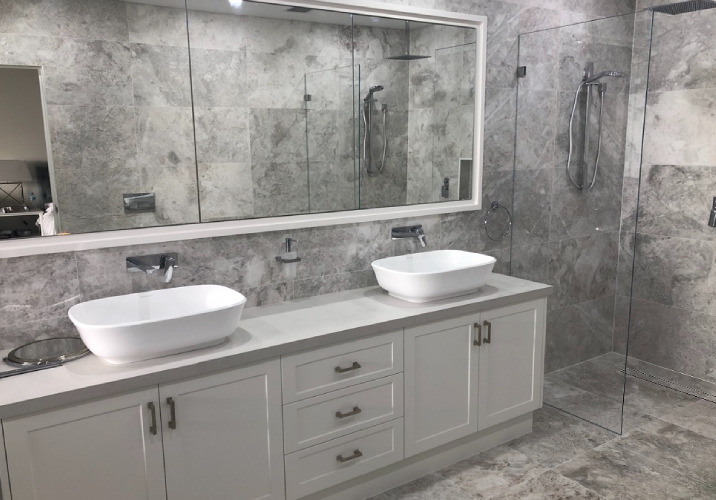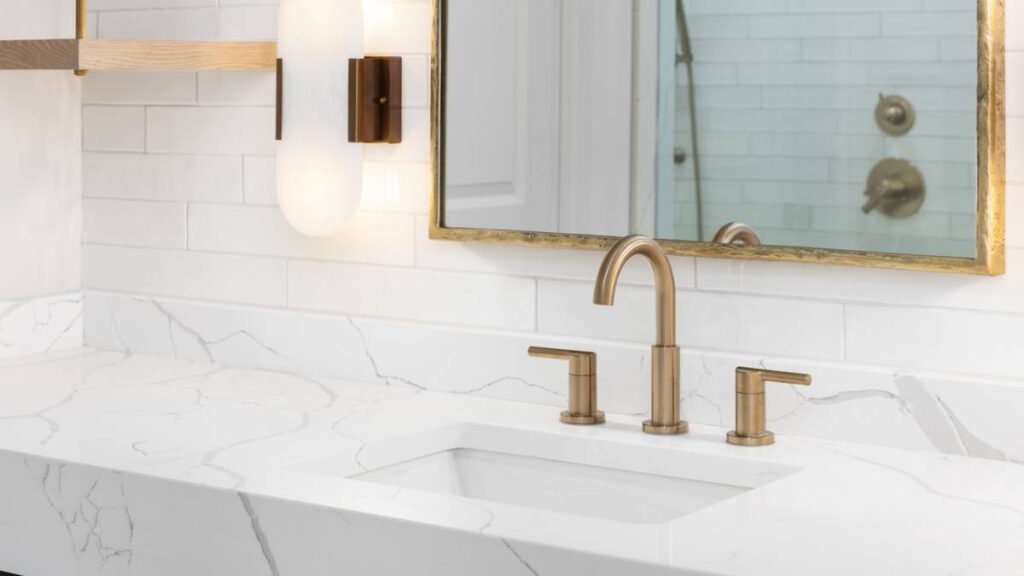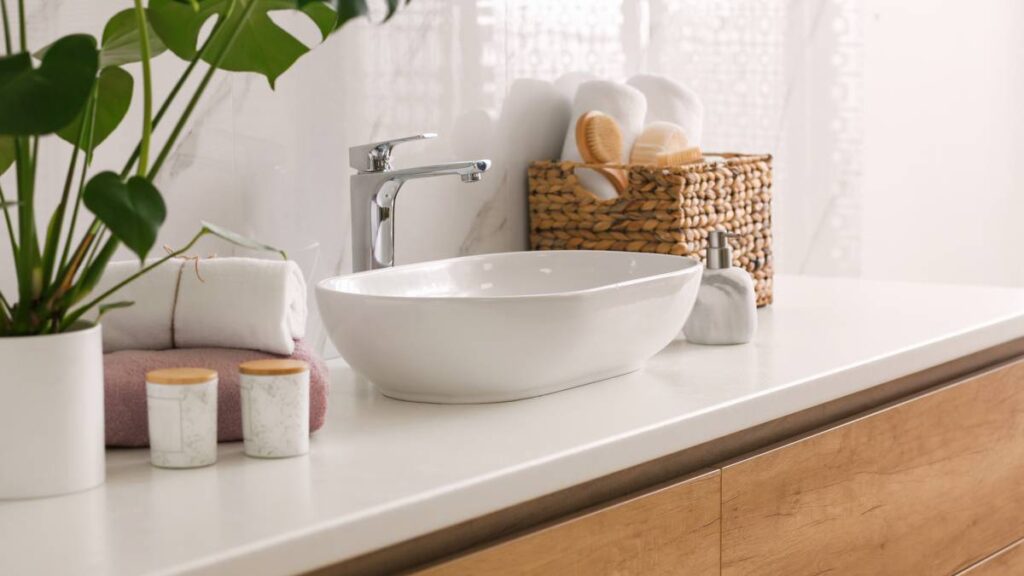Choosing the right bathroom paint colours is important for creating an inviting, soothing, and functional environment. In this guide, we’ll look at a variety of bathroom paint colour schemes to help you transform your bathroom into a sanctuary of comfort and style.
11 bathroom paint colour ideas
1. Serene and creamy white

Ideal for minimalist or contemporary aesthetics, as well as those wanting a clean, airy space, white paint brings a timeless elegance to the bathroom or powder room. It creates an illusion of space, making it one of the best paint colours for small bathrooms while also providing a versatile neutral backdrop for various decor styles.
To enhance this colour, complement it with touches of natural textures like rattan or bamboo for warmth.
2. Bold black accents
Do you want a bold and dramatic design for your bathroom walls? Black paint creates a striking contrast against lighter wall colours, making a powerful design statement.
Pair this colour with sleek, modern chrome or stainless steel fixtures and accessories to emphasise its best features. You may also consider incorporating wall painting techniques like geometric patterns or graphic artwork to amplify the contemporary aesthetic and balance the darkness with pops of vibrant colours or metallic accents for visual interest.
3. Subtle grey elegance
Grey is one of the modern bathroom paint colours perfect for creating a sense of understated sophistication. It’s softer than a bright white, yet emanates classic features. If you dislike bold colours but don’t want to stick with white, go with a soft grey. You may also consider layering multiple shades of grey to add depth and complexity to this colour.
4. Energising earthy greens

Whether you’re a nature enthusiast or simply want an organic vibe in your bathroom, wall or tile colours ranging from soft sage to deep shades of forest green evoke a connection with the outdoors. Incorporate natural elements such as wood, stone, or rattan in the decor if you want an earthier vibe.
You may also contrast the richness of the green tones by using white fixtures and accessories and adding bursts of lively colours such as mustard yellow or terracotta for visual flair. To complement the natural motif, consider using botanical prints or leafy plants.
5. Playful blush pink
If you enjoy a touch of romance and softness in your surroundings, you might love playful blush pink as your bathroom paint colour! Adding white accents and floral prints to your bathroom walls adds warmth and femininity to the space and can be further elevated.
6. Electric violet
With electric violet, you can display allure and edgy sophistication for your bathroom. This vibrant and bold shade makes a powerful statement on its own, allowing the rest of the bathroom decor to remain minimalistic. Pairing electric violet with sleek and simple furnishings such as a mirror, towel rack, and pedestal sink creates a striking contrast that highlights the intensity of the colour.
7. Calming coastal blues

Are you looking for a seaside-inspired hideaway? Coastal blue bathroom paint colours, reminiscent of the ocean and sky, can create a relaxing and peaceful atmosphere!
For a beachy vibe, accent this colour with natural materials like driftwood, seagrass or shells. Pair with white or sandy beige for a light and airy look, and add navy or blue for depth and contrast. To complement the beach motif, consider using nautical elements such as rope detailing or striped patterns.
8. Golden hour orange
One of the warm paint colours you can use for the bathroom, orange hues, brings a vibrant energy to the space, similar to that of the golden hour when the sun casts a beautiful glow. These hues create a flattering cast when you’re dressing up, regardless of the hour, making these the suitable bathroom vanity paint colours. Incorporate white or cream to balance the orange tones and add soft lighting fixtures or candles to create a sense of freshness.
9. Lemony yellow
With the bright and cheery colour of lemony yellow in your bathroom, you may enjoy a comfortable warmth all year round! This brilliant colour evokes a sense of enthusiasm and vibrancy in a space, that reminds of sunny days and citrus groves.
This colour palette, combined with alabaster and slate grey, strikes a perfect blend of freshness and sophistication. You may enhance this colour palette with Mediterranean-inspired details like Spanish tile floors and traditional clawfoot tubs.
10. Sun-scorched terracotta

Terracotta can be used on bathroom walls to bring a rustic and earthy charm to the space. You may combine this with other earthy, clay-hued tones to create a coherent colour scheme, or you may add matte black accents to contrast the warmth of the terra cotta. Include tribal-patterned decorations to reinforce the desert vibe, providing texture and visual interest to the space.
11. Bold crimson red
Red paint or tiles, particularly in bold shades like crimson, are not for the faint of heart, yet they communicate strength and confidence. Despite its intensity, crimson red has a more universal tone, appealing to a broader spectrum of tastes. Pairing this passionate colour with natural components like wood or stone gives it a more grounded feel, moderating the red’s intensity while keeping its energy presence in the space.
4 tips when selecting a bathroom colour scheme
Consider lighting
Take into account the natural and artificial lighting in your bathroom when selecting paint colours. Lighter hues can help brighten up a dark space, while darker colours can add depth and drama to a well-lit room.
1. Think about size
Lighter colours can make a small bathroom feel more spacious, while darker colours can make a large bathroom appear cosy and intimate. Consider the size and layout of your bathroom when choosing paint colours.
2. Coordinate with fixtures and accessories
Coordinate your paint colours with the existing fixtures, tiles and accessories in your bathroom for a cohesive look. Choose colours that complement rather than clash with the existing elements in the space.
3. Test before you commit
Always test paint colours on a small section of the wall before committing to a full application. Colours can look different once they’re on the wall, so it’s essential to see how they look in your specific space.
4. Consider maintenance
Keep in mind that bathrooms are high-moisture environments, so choose paint finishes that are durable and easy to clean. Semi-gloss and satin finishes are ideal for bathrooms as they resist moisture and are easy to wipe down.
Transform your bathroom with colour
Selecting the right paint for bathroom walls and tiles is an exciting opportunity to express your style and create a space that reflects your personality and taste. Whether you prefer calming neutrals, bold jewel tones or vibrant hues, there’s a perfect paint colour out there waiting for you!
If you’re unsure where to start your next bathroom makeover, consider hiring a professional painter who can help bring your vision to life. Your bathroom can become a sanctuary of style, comfort, and relaxation with their expertise and guidance!
FAQs on bathroom paint colour ideas
What is the best colour to paint a small bathroom with no natural light?
Choosing light and airy colours that can help brighten the space is best. Opting for soft whites, pale greys, powder blues, light beiges, or pale yellows can make the room feel larger and more inviting by reflecting more light. These colours create a sense of openness and freshness, enhancing the overall ambience of the bathroom.
Do you need special wall paint in the bathroom?
Yes, it’s recommended to use special wall paint designed for bathrooms. Bathrooms are typically high in moisture and humidity, which can lead to issues like mould, mildew, and peeling paint if regular wall paint is used.
Special bathroom paint formulations are designed to withstand these conditions better, offering features such as mould and mildew resistance, moisture resistance, and easy cleaning. Look for paints labelled as “bathroom paint,” “kitchen and bath paint,” or “moisture-resistant paint” to ensure durability and longevity in your bathroom.
What paint colour goes with grey tiles in the bathroom?
Grey tiles in a bathroom can be complemented with various colours to create a coherent look. Choose soft white for a clean, timeless look or cool blues like aqua or navy for a relaxing spa setting.
Warm neutrals like beige or taupe can warm up the space, while modest greens give a natural and peaceful accent. Consider testing paint samples to find the perfect match for your specific shade of grey tiles and personal style preferences.


















